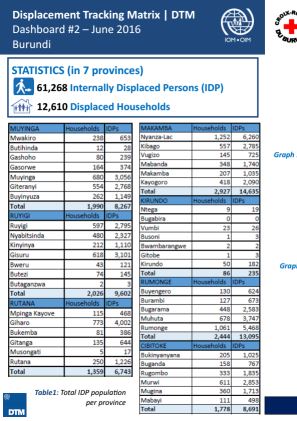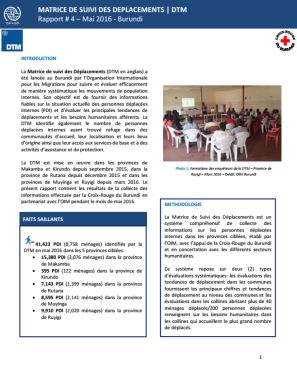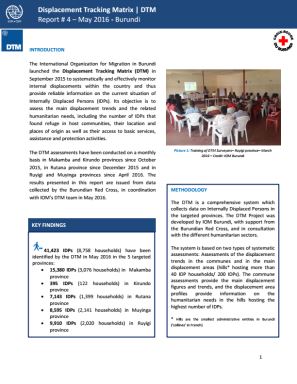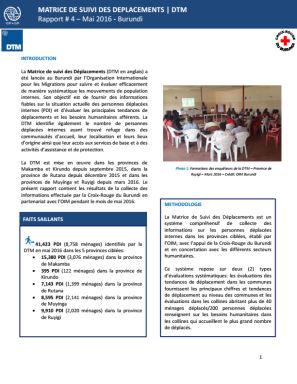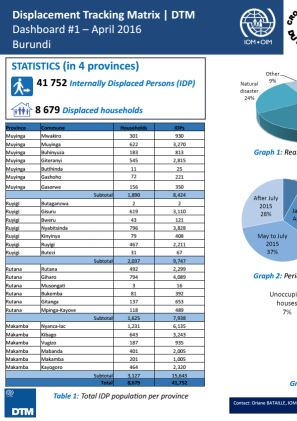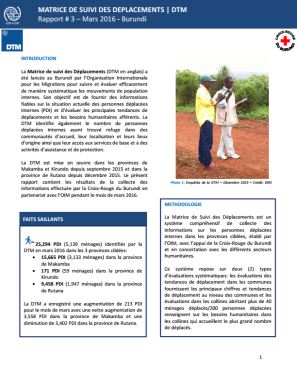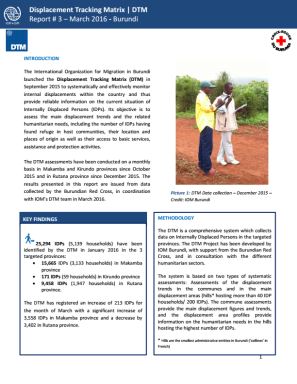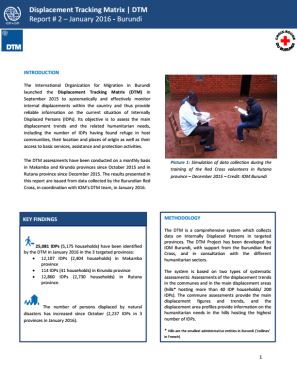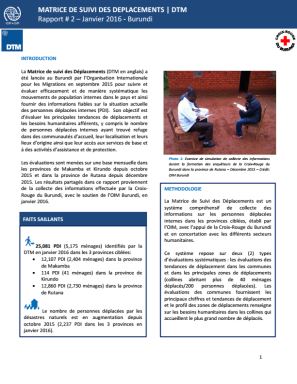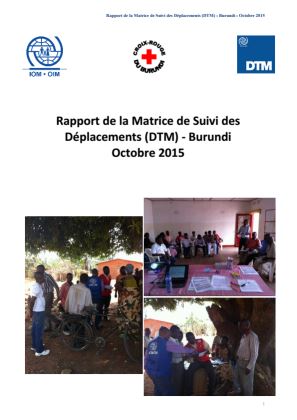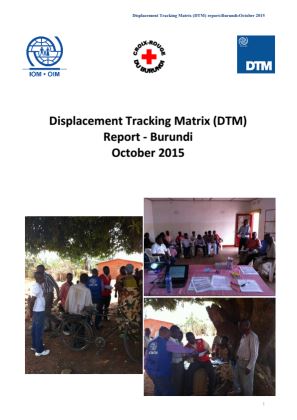-
Countries
-
Data and Analysis
-
Special Focus
-
Crisis Responses
Burundi
Burundi
Desplazados internos rastreados
Movimientos de desplazamiento
8,100
IDMC 2023
Ronda de recopilación de datos
Sobre Burundi
In response to the great need for information on internally displaced persons (IDPs), their humanitarian profile and needs, as identified by the humanitarian community and the Burundian authorities, the International Organization for Migration (IOM) implemented DTM since 2015 to effectively and systematically track and assess internal population flows in Burundi and therefore provide reliable information on the current situation of IDPs.
The Displacement Tracking Matrix monitors IDPs on a national level and to identify their humanitarian needs. The DTM’s main objective is to maintain a comprehensive system of data collection and sharing on IDPs. The project relies on the synergy between IOM's DTM and the Burundi Red Cross (BRC), who are jointly responsible for data collection on internally displaced persons. The collected data includes figures on displacement, as well as displacement centres, provenance locations, approximate duration of displacement and humanitarian needs of the displaced populations. The information collected at various levels contributes to the construction of an overall profile of the displaced population in targeted provinces, which can then be used by the government and the humanitarian partners in order to protect, assist and advocate for IDPs.
In November 2018, DTM Burundi also began to collect data on movement at unofficial points of transit on the Burundi - Tanzania border. The information collected at the flow monitoring points enable the government, humanitarian partners and policy stakeholders, to understand migration trends on the national and regional levels.
Contacto
DTMBurundi@iom.int
Current Donors
- PRM
- BHA
- Japan
- Republic of Korea
- Swiss (SDC)
- GFFO
Para obtener resultados de búsqueda más avanzados, vaya a la Página de búsqueda avanzada de informes
Burundi — Displacement Dashboard 3 (August 2016)
DTM recorded 59,758 IDPs (12,472 households) in seven provinces. Most IDPs were found in Makamba (13,255 IDPs or 2,651 households). 58% of IDPs reported socio-political reasons for their displacement and 40% were displaced by natural disasters. 2% fled for 'other' reasons.
Aug 31 2016
Burundi — Displacement Dashboard 3 (August 2016)
Burundi — Rapport de déplacement 5 (Juillet 2016)
Pendant le mois de juillet 2016, les données ont été collectées sur les personnes déplacées internes au sein de sept (7) provinces avec des informations fournies par 1,774 informateurs-clé dans les provinces ciblées. Les données des collines ont été collectées dans six (6) provinces
Burundi — Dashboard des déplacements 2 (Juin 2016)
En juin 2016, DTM a identifié 61 268 PDI dans sept provinces. La plupart des PDI résident dans la province de Makamba (14 635 PDI soit 2 927 ménages).
Burundi — Displacement Report 5 (July 2016)
58,461 IDPs (11,698 households) have been identified by the DTM in July 2016 in seven targeted provinces. The majority of IDPs identified in July 2016 left their homes due to the current socio-political situation (66%). 33% of IDPs fled due to natural disasters.
Jul 31 2016
Burundi — Displacement Report 5 (July 2016)
Burundi — Displacement Dashboard 2 (June 2016)
DTM recorded 61,268 IDPs (12,610 households) in seven provinces. Most IDPs were found in Makamba (14,635 IDPs or 2,927households). 68% of IDPs reported socio-political reasons for their displacement and 29% were displaced by natural disasters. 3% fled for 'other' reasons.
Jun 30 2016
Burundi — Displacement Dashboard 2 (June 2016)
Burundi — Rapport de déplacement 4 (Mai 2016)
La Matrice de suivi des Déplacements (DTM en anglais) a été lancée au Burundi par l’Organisation Internationale pour les Migrations en septembre 2015 pour suivre et évaluer efficacement et de manière systématique les mouvements de population internes dans le pays et ainsi fournir des inform
Jun 27 2016
Burundi — Rapport de déplacement 4 (Mai 2016)
Burundi — Displacement Report 4 (May 2016)
In May 2016, the DTM assessments covered five provinces: Muyinga, Ruyigi, Rutana, Makamba and Kirundo. The assessments identified 41,423 IDPs in 8,758 households. The displaced population is composed of 46% men and boys and 54% women and girls.
May 31 2016
Burundi — Displacement Report 4 (May 2016)
Burundi — Dashboard des déplacements 1 (Avril 2016)
En avril 2016, DTM a identifié 41 752 PDI dans quatre provinces. La plupart des PDI résident dans la province de Makamba (15 643 PDI soit 3 127 ménages). 67% des PDI ont été déplacées en raison de la situation socio-politique et 24% ont été déplacées à la suite désatrses naturels.
Burundi — Displacement Dashboard 1 (April 2016)
DTM recorded 41,752 IDPs in four provinces. Most IDPs were counted in Makamba province (15,643 IDPs or 3,127 households). 67% of IDPs reported socio-political reasons for their displacement and 24% were displaced by natural disasters. 9% fled for 'other' reasons.
Apr 28 2016
Burundi — Displacement Dashboard 1 (April 2016)
Burundi — Rapport de déplacement 3 (Mars 2016)
La Matrice de suivi des Déplacements (DTM en anglais) a été lancée au Burundi par l’Organisation Internationale pour les Migrations en septembre 2015 pour suivre et évaluer efficacement et de manière systématique les mouvements de population internes dans le pays et ainsi fournir des inform
Apr 19 2016
Burundi — Rapport de déplacement 3 (Mars 2016)
Burundi — Displacement Report 3 (March 2016)
25,294 IDPs (5,139 households) have been identified by the DTM in March 2016 in 3 targeted provinces: 15,665 IDPs (3,133 households) in Makamba province; 171 IDPs (59 households) in Kirundo province; 9,458 IDPs (1,947 households) in Rutana province.
Mar 31 2016
Burundi — Displacement Report 3 (March 2016)
Burundi — Displacement Report 2 (January 2016)
25,081 IDPs (5,175 households) have been identified by the DTM in January 2016 in 3 targeted provinces: 12,107 IDPs (2,404 households) in Makamba province; 114 IDPs (41 households) in Kirundo province; 12,860 IDPs (2,730 households) in Rutana province.
Jan 31 2016
Burundi — Displacement Report 2 (January 2016)
Burundi — Rapport de déplacement 2 (Janvier 2016)
La Matrice de suivi des Déplacements (DTM en anglais) a été lancée au Burundi par l’Organisation Internationale pour les Migrations en septembre 2015 pour suivre et évaluer efficacement et de manière systématique les mouvements de population internes dans le pays et ainsi
Burundi — Rapport de déplacement 1 (Octobre 2015)
L’année 2015 au Burundi a été marquée par des mouvements de population, dont des déplacements internes de personnes. l’Organisation internationale pour les Migrations (OIM) a développé dès mai 2015 un système de Matrice de Suivi des Déplacements (ou Displacement Tracking Matrix - DTM en angl
Burundi — Displacement Report 1 (October 2015)
On 31 October 2015, the total number of IDPs identified through the DTM in the two provinces of Kirundo and Makamba is 14,804 IDPs. The Makamba province hosts 14,715 IDPs and the Kirundo province hosts 89 IDPs.
Oct 31 2015
Burundi — Displacement Report 1 (October 2015)
Pagination
- First page
- Previous page
- …
- 16
- 17
- 18
- 19
- 20
- 21
- 22
- 23
- 24
Para obtener resultados de búsqueda más avanzados, vaya a la Página de búsqueda avanzada de conjuntos de datos
Pagination
- First page
- Previous page
- 1
- 2
- 3
- 4
- 5
- 6
- 7
- 8






